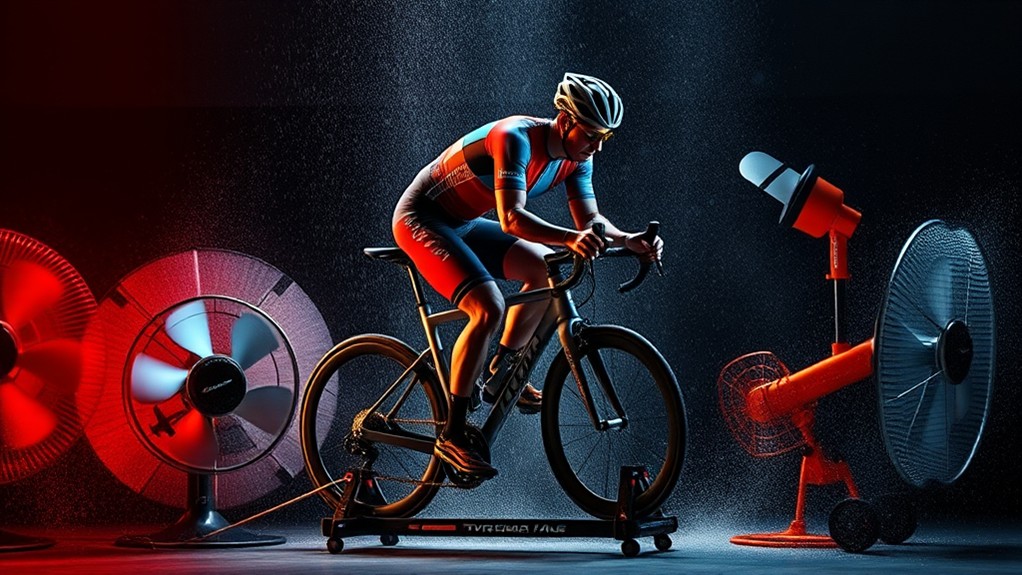When it pertains to turbo training, having the right number of fans is essential for maintaining a comfortable temperature and enhancing your workout performance. The ideal number of fans depends on the intensity of your workout and the size of your training area. For light training, one fan may suffice, but for moderate to high-intensity workouts, two to three fans are recommended, and for extreme heat or prolonged training, four or more fans can be advantageous. Remember to position fans strategically to improve airflow efficiency, and as you experiment with different fan setups, you'll find the perfect balance for your turbo training needs – and uncover even more ways to take your workouts to the next level.
Fan Selection and Specifications
In the domain of turbo training, selecting the right fans is vital to replicating outdoor cooling conditions.
Regarding fan selection, you'll want to take into account fan power, measured in CFM (Cubic Feet per Minute). Effective fans typically provide at least 7500 CFM to replicate outdoor cooling conditions. You may want to explore popular fan options like the Honeywell Turbo fan, known for its quiet operation and good airflow, or the Sealey HVF18, which can move 107 cubic meters per minute.
In addition to fan power, fan placement is also significant. Using multiple fans strategically can improve airflow and reduce overheating, especially in warmer conditions.
Remote-controlled fans with adjustable speed settings can provide flexibility during workouts, allowing you to tailor airflow to your training intensity. Be mindful of noise levels, as some fans can operate at 67 dB, comparable to a vacuum cleaner.
Balance airflow performance with acceptable noise levels to create a distraction-free environment. By taking these factors into account, you'll be able to create an optimal cooling setup for your turbo training sessions.
Types of Indoor Fans and Features
You've got your fan power and placement sorted, now it's time to investigate the different types of indoor fans that can help you replicate outdoor cooling conditions during turbo training.
From floor fans to wall-mounted fans, pedestal fans, table fans, and cyclone fans, each design variation offers unique benefits like portability or high-speed airflow suitable for intense workouts.
When choosing the right fan for your turbo training setup, consider the following key features:
- Airflow Speed: Look for fans that produce airflow above 7500 CFM for an effective cooling experience.
- Noise Level: Opt for fans with a noise rating between 41-61 dB for a distraction-free workout.
- Oscillation: This feature improves airflow distribution, allowing fans to cover a wider area and provide better cooling during intense training sessions.
- Energy Efficiency: Choose fans with lower wattage consumption to reduce electricity bills and guarantee consistent cooling without excessive energy use.
Benefits of Using Fans and Cooling

As you step into your turbo training zone, the benefits of using fans and cooling become increasingly clear. You'll be able to manage your body temperature, preventing overheating that can hinder your performance and increase your perceived exertion (RPE).
Effective airflow from fans promotes sweat evaporation, improving cooling and allowing for longer and more comfortable training sessions. This means you'll be able to push yourself harder and longer, leading to considerable performance improvement.
Furthermore, fans improve air circulation in indoor training environments, reducing the risk of stale air that can affect your respiration and performance. By incorporating multiple fans, you can considerably increase airflow, with a minimum indoor output of around 7500 CFM recommended to replicate outdoor cooling conditions.
Plus, fans are a cost-effective alternative to air conditioning, consuming less energy while providing crucial cooling during intense workouts, thereby improving overall workout efficiency.
Necessity of a Fan and Popular Brands
While turbo training can be done without a fan, the benefits of using one are undeniable, and for most cyclists, it's a worthwhile investment to prevent overheating that can greatly hinder exercise performance.
In fact, fan effectiveness plays a significant role in enhancing your workout quality and comfort.
When it comes to choosing a fan, you have several popular brands to evaluate:
- Vornado: Known for their high-velocity fans that can move a large volume of air.
- Lasko: Offers a range of fans with varying features, from compact to tower fans.
- Honeywell: Provides fans with advanced features like wind tunnel technology and oscillation.
- Dyson: Famous for their high-tech, bladeless fans that are both stylish and effective.
These brands cater to different needs and budgets, so you're sure to find one that suits your turbo training setup.
Maintenance Tips for Optimal Performance

Clean and maintain your fans regularly to guarantee they continue delivering optimal airflow and performance during your turbo training sessions.
Regular fan cleaning is crucial to prevent dust buildup, which can hinder performance. Start by wiping down the fan blades and grills with a soft cloth to remove dirt and debris.
Next, inspect the cords and plugs for damage to verify electrical safety and reduce the risk of fire hazards.
To further prolong the lifespan of your fan, lubricate moving parts, such as bearings, using lubrication techniques. This minimizes friction, keeping your fan running efficiently.
When not in use, store your fans in a dry, cool place to prevent wear and tear.
Ultimately, regularly test the functionality of your fans by checking for consistent airflow and noise levels. This helps identify any maintenance needs before your workouts, guaranteeing your fans are always ready to perform.
Determining Individual Cooling Needs
When you're setting up your turbo training space, determining your individual cooling needs is crucial to guarantee you stay comfortable and perform at your best.
You'll want to take into account factors like your personal cooling preferences, workout intensity, and the ambient temperature of your training space.
- Assess your cooling preferences: Do you tend to feel hotter or colder than others during exercise? This will help you determine the minimum fan output you need.
- Reflect on your workout intensity: High-intensity sessions require more airflow to prevent excessive sweating, while low-intensity workouts may need less.
- Evaluate your training space temperature: Warmer rooms require more fan power to maintain a comfortable temperature.
- Test and adjust fan placement: Experiment with different fan placements and quantities to optimize airflow and guarantee effective sweat evaporation.
Airflow Dynamics and Performance Testing

To improve your turbo training performance, you need to understand the airflow dynamics that make a significant difference in your workout experience. Effective cooling requires a minimum fan output of around 7500 CFM to replicate outdoor airflow conditions achieved at higher speeds.
Regarding fan efficiency, airflow patterns play an important role. Directional airflow is necessary for optimal skin cooling, as adequate airflow assists in sweat evaporation, which is critical for maintaining core temperature during intense workouts.
During performance testing, air speed was measured at 40 cm from the fan grill to guarantee riders experienced consistent airflow that mimicked outdoor conditions. The results varied, with some fans providing airflow as low as 2.7 mph, while others reached up to 15.8 mph, impacting their overall cooling effectiveness.
Furthermore, noise levels were recorded, often exceeding 60 dB, which can disrupt training. Finding a balance between airflow efficiency and noise levels is key to an optimal turbo training experience.
Ambient Conditions and Cooling Strategies
You're about to step up your turbo training game by optimizing your indoor training space's ambient conditions and cooling strategies. This is essential since the indoor temperature and workout humidity can greatly impact your performance.
To get it right, consider the following:
- Lower the temperature: Aim for around 69°F (20.5°C) to improve cooling efficiency and comfort.
- Adjust for humidity: Factor in sweat production, workout intensity, and room humidity when positioning and using fans.
- Creative fan placement: Angle fans towards your body and place them at wheel height to optimize airflow and cooling.
- Utilize multiple fans: This allows for customizable airflow management, replicating outdoor conditions and preventing overheating.
Frequently Asked Questions
How Much Space Do You Need for a Turbo Trainer?
You'll need a space with turbo trainer dimensions in mind, aiming for an optimal training space of at least 2 meters by 1.5 meters, with 60 cm clearance around the bike for safe dismounting and proper ventilation.
How Many Fans Do You Need for Good Airflow?
You're wondering how many fans you need for good airflow. It depends on fan types and airflow efficiency. For optimal performance, consider high-velocity fans like Lasko or Stanley, and position them strategically to enhance airflow efficiency, ensuring you stay cool and comfortable during your workout.
How Do I Keep My Turbo Trainer Cool?
You keep your turbo trainer cool by strategically placing fans at wheel height, angled towards your body, and using cooling techniques like ice or a wet towel on your neck to enhance airflow and comfort during intense workouts.
How Do You Train on a Turbo Trainer?
You train on a turbo trainer by setting resistance levels that mimic outdoor routes, focusing on cadence training to maintain a consistent pace, and adjusting your gear to simulate real-world cycling conditions, ensuring a challenging and effective workout.
